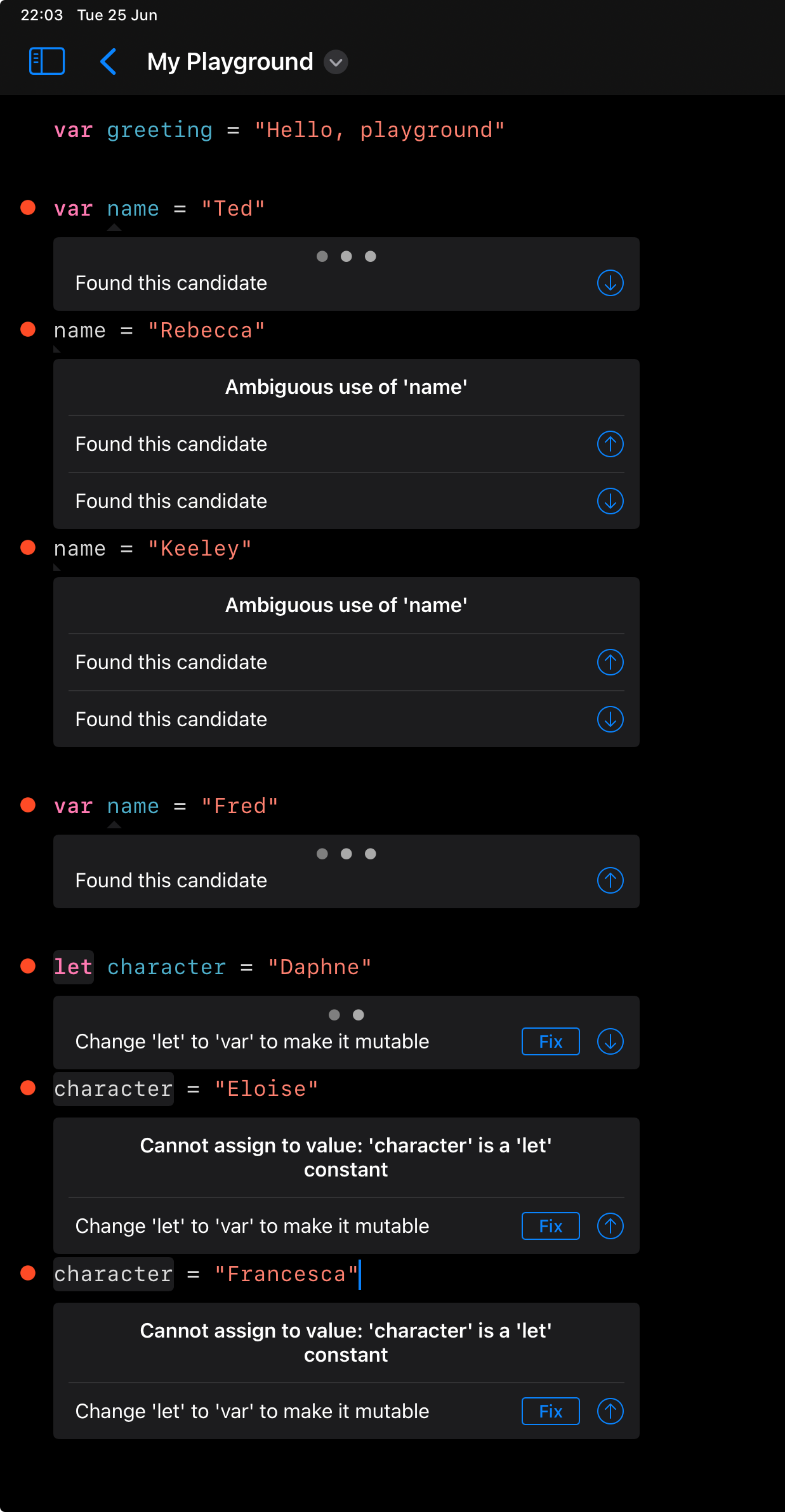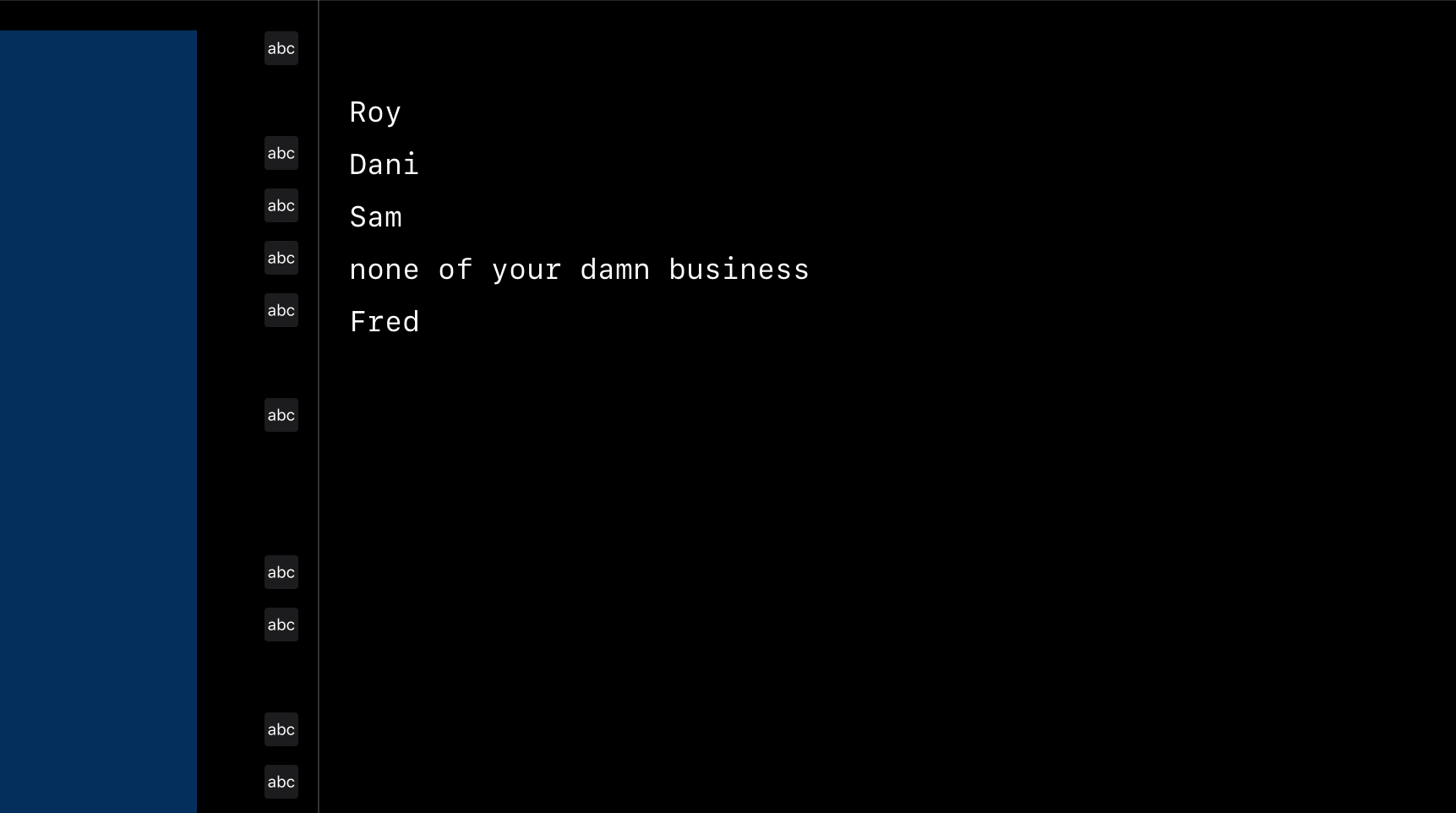Swift Notes
100 Days of Swift:
Day 1
Variable’s you can change their value whenever var name = “Ted”
Can then go
name = “Fred”
var name = "Ted"
name = "Rebecca"
name = "Keeley"Or whatever and “Ted” will be forgotten about
If don’t ever want to change the value, can use a constant instead
let character = "Daphne"
It won’t let you change the value of the character because that’s set as a constant.
var greeting = "Hello, playground"
var name = "Ted"
name = "Rebecca"
name = "Keeley"
name = "Fred"
let character = "Daphne"
var playerName = "Roy"
print(playerName)
playerName = "Dani"
print(playerName)
playerName = "Sam"
print(playerName)
playerName = "none of your damn business"
print(playerName)
print(name)
Will, when ran, spit out:

Using constants instead of variables lets swift optimise code a bit better but also make it harder for me to accidentally change/mistype a variable by accident.
Can have quotes within strings, but have to backlsalsh em out, like:
let quote = "Then he tapped a sign saying \"Believe\" and walked away."Can do multi line strings using three quotes
let movie = "A day in
the life of an
Apple engineer"Won’t work, but this will:
let movie = """
A day in
the life of an
Apple engineer
"""Can read the length of a string. EG
print(actor.count)Would return 17 for “Denzel Washington”
Or can add them as their own constant and grab em “easier”. That might make more sense once there’s a lot of code to go through or something.
let nameLength = actor.count
print(nameLength)Can call/print results in uppercase with
print(result.uppercased())These could be handy for looking stuff up/debugging
print(movie.hasPrefix("A day"))print(filename.hasSuffix(".jpg"))Remember that those are case sensitive though. So prefix “a day” or suffix “JPG” would return FALSE
Below here is Stuff from Donking around in Swift Playgrounds without Really Knowing what I’m Doing.
Boolean is either true OR false. Meaning we can write conditional code. If
true, the “If” bit will run, if false, the “else” bit will run.
Examples/code Snippets:
Loops
Eg:
CODE
for i in 1…4{
moveForward()
collectGem()
moveForward()
moveForward()
moveForward()
turnRight()
}
If Statements
EG (with a loop):
Code
for i in 1 … 4{
moveForward()
if isOnClosedSwitch {
toggleSwitch()
}
}
Else If
Code
for i in 1 … 2{
moveForward()
if isOnClosedSwitch {
toggleSwitch()
} else if isOnGem {
collectGem()
}
}
Code
for i in 1 … 10 { Commands go here }
if or else if
&& - both conditions must be true
! NOT - makes it the opposite, so the condition must be false
|| OR - if either condition is true, code will run
Logical Operators
AND - && - Runs only if all conditions are true
OR - || - Runs if at least one condition is true
NOT - ! - Does the opposite. Eg if onGem is true, !onGem is false
EG
Code
for i in 1 … 4 {
moveForward()
if isOnGem {
collectGem()
} else if !isOnGem || isBlocked {
turnLeft()
moveForward()
moveForward()
collectGem()
turnLeft()
turnLeft()
moveForward()
moveForward()
turnLeft()
}
}
Variables
Like a container for information
Int
String
Once something has an int value it can’t then have a string value later, and vice versa
Eg:
Code
for i in 1 … 21 {
if isOnGem{
collectGem()
gemCounter = gemCounter + 1
} else if !isOnGem{
moveForward()
}
if isBlocked{
turnRight()
}
}
Thing I forget is you gotta do “nameofvariable = nameofvariable + 1” or whatevers, NOT just “nameofvariable + 1”
A Type is like a blueprint.
Has features called properties - Like defined variables
Has behaviours called methods - Like defined functions
An Instance is like a house built from said blueprint. In this example, “blueportal” and “pinkportal” are instances, “isActive” is the state
Code
bluePortal.isActive = false
pinkPortal.isActive = false
moveForward()
moveForward()
moveForward()
collectGem()
turnLeft()
turnLeft()
pinkPortal.isActive = true
moveForward()
turnLeft()
turnLeft()
moveForward()
collectGem()
turnLeft()
turnLeft()
moveForward()
bluePortal.isActive = true
moveForward()
moveForward()
collectGem()
bluePortal.isActive = false
turnLeft()
turnLeft()
moveForward()
moveForward()
collectGem()
Initialisation
Let blahblah = blahblah() “turns it on”
Code
Let expert = Expert()
expert.moveForward()
expert.moveForward()
expert.moveForward()
expert.turnLockUp()
expert.turnLeft()
expert.turnLeft()
expert.moveForward()
expert.moveForward()
expert.moveForward()
expert.turnLeft()
for i in 1 … 3{
expert.moveForward()
expert.moveForward()
expert.moveForward()
expert.collectGem()
expert.turnLeft()
expert.turnLeft()
expert.moveForward()
expert.moveForward()
expert.moveForward()
expert.turnLeft()
}
Functions
Get ya func set up first. Lets you name a set of commands to be run.
Eg func tieMyShoe(){
Loop()
Swoop()
Pull()
}
Code
func gemnSwitch() { moveForward()
collectGem()
moveForward()
toggleSwitch() }
for i in 1 … 4{
gemnSwitch()
moveForward()
moveForward()
turnLeft()
}
Parameters
Have an input value to function - type
When calling the function, pass an argument that customises HOW it runs
Code
let expert = Expert()
func move(distance: Int) {
}
expert.move(distance:6)
expert.turnRight()
expert.move(distance:2)
expert.turnRight()
expert.move(distance:5)
expert.turnLeft()
expert.move(distance:5)
expert.turnLeft()
expert.turnLockUp()
expert.turnLeft()
expert.move(distance:3)
expert.turnRight()
expert.move(distance:3)
expert.turnRight()
expert.move(distance:4)
expert.collectGem()
Code
let expert = Expert()
world.place(expert, atColumn: 1, row: 5)
func move(distance: Int) {
}
expert.turnLeft()
expert.turnLeft()
expert.moveForward()
expert.collectGem()
expert.turnRight()
expert.moveForward()
expert.turnLockUp()
expert.turnRight()
expert.move(distance:5)
expert.turnRight()
expert.moveForward()
expert.collectGem()
expert.turnRight()
expert.turnRight()
expert.moveForward()
expert.turnLockUp()
expert.turnRight()
expert.move(distance:6)
expert.collectGem()
Swift UI Views
Deffo a little bit lost to start with
Code
import SwiftUI
/-code-walkthrough(1.first)/
struct/-code-walkthrough(1.introView)/ IntroView: /-code-walkthrough(1.introView)/ View {
/-code-walkthrough(1.body)/
var body: some View {
//#-learning-task(placeOneViewInsideAnother)
//#-learning-task(addImageInHStack)
//#-learning-task(modifierWalkthrough)
/-code-walkthrough(2.bothModifiers)/
//#-learning-task(addFriend)
//#-learning-task(modifier)
/-code-walkthrough(2.bothModifiers)/
//#-learning-task(changeText)
/-code-walkthrough(1.text)/
Text(“Bonsoir, Amigo.”)
Text (“here is some more text”)
/-code-walkthrough(1.text)/
//#-learning-task(textElement)
}
/-code-walkthrough(1.body)/
}
/-code-walkthrough(1.preview)/
struct IntroView_Previews: PreviewProvider {
static var previews: some View {
VStack {
IntroView()
}
}
}
/-code-walkthrough(1.preview)/
/-code-walkthrough(1.first)/
Code
import SwiftUI
/-code-walkthrough(1.first)/
struct/-code-walkthrough(1.introView)/ IntroView: /-code-walkthrough(1.introView)/ View {
/-code-walkthrough(1.body)/
var body: some View {
//#-learning-task(placeOneViewInsideAnother)
//#-learning-task(addImageInHStack)
//#-learning-task(modifierWalkthrough)
/-code-walkthrough(2.bothModifiers)/
//#-learning-task(addFriend)
//#-learning-task(modifier)
/-code-walkthrough(2.bothModifiers)/
//#-learning-task(changeText)
/-code-walkthrough(1.text)/
Text(“Bonsoir, Amigo.”)
Text (“here is some more text”)
Image(“FriendAndGem”)
.resizable()
.scaledToFit()
/-code-walkthrough(1.text)/
//#-learning-task(textElement)
}
/-code-walkthrough(1.body)/
}
/-code-walkthrough(1.preview)/
struct IntroView_Previews: PreviewProvider {
static var previews: some View {
VStack {
IntroView()
}
}
}
/-code-walkthrough(1.preview)/
/-code-walkthrough(1.first)/
Hstacks
Let you place a view within another view. Or something?
Code
import SwiftUI
/-code-walkthrough(1.first)/
struct/-code-walkthrough(1.introView)/ IntroView: /-code-walkthrough(1.introView)/ View {
/-code-walkthrough(1.body)/
var body: some View {
HStack {
Text (“this is in the hstack”)
}
//#-learning-task(addImageInHStack)
//#-learning-task(modifierWalkthrough)
/-code-walkthrough(2.bothModifiers)/
//#-learning-task(addFriend)
//#-learning-task(modifier)
/-code-walkthrough(2.bothModifiers)/
//#-learning-task(changeText)
/-code-walkthrough(1.text)/
Text(“Bonsoir, Amigo.”)
Text (“here is some more text”)
Image(“FriendAndGem”)
.resizable()
.scaledToFit()
/-code-walkthrough(1.text)/
//#-learning-task(textElement)
}
/-code-walkthrough(1.body)/
}
/-code-walkthrough(1.preview)/
struct IntroView_Previews: PreviewProvider {
static var previews: some View {
VStack {
IntroView()
}
}
}
/-code-walkthrough(1.preview)/
/-code-walkthrough(1.first)/
So like this, the image appears beside the text, rather than above/below it. Guessing the “h” in hstack refers to “horizontal”. So they get arranged horizontally rather than vertically.
Code
import SwiftUI
/-code-walkthrough(1.first)/
struct/-code-walkthrough(1.introView)/ IntroView: /-code-walkthrough(1.introView)/ View {
/-code-walkthrough(1.body)/
var body: some View {
HStack {
Text (“this is in the hstack”)
Image(“FriendAndGem”)
.resizable()
.scaledToFit()
}
//#-learning-task(addImageInHStack)
//#-learning-task(modifierWalkthrough)
/-code-walkthrough(2.bothModifiers)/
//#-learning-task(addFriend)
//#-learning-task(modifier)
/-code-walkthrough(2.bothModifiers)/
//#-learning-task(changeText)
/-code-walkthrough(1.text)/
Text(“Bonsoir, Amigo.”)
Text (“here is some more text”)
/-code-walkthrough(1.text)/
//#-learning-task(textElement)
}
/-code-walkthrough(1.body)/
}
/-code-walkthrough(1.preview)/
struct IntroView_Previews: PreviewProvider {
static var previews: some View {
VStack {
IntroView()
}
}
}
/-code-walkthrough(1.preview)/
/-code-walkthrough(1.first)/
Views in views in view. It’s views all the way down:
Code
import SwiftUI
struct FriendDetailView: View {
var body: some View {
VStack {
HStack {
Image(“Friend”)
.resizable()
.scaledToFit()
VStack {
Text (“Friendo”)
.font(.largeTitle)
}
//#-learning-task(addTextInVStack)
//#-learning-task(describeFriend)
}
}
}
}
struct FriendDetailView_Previews: PreviewProvider {
static var previews: some View {
VStack {
FriendDetailView()
}
}
}
So with this, the image and text appear side by side, but because both sets of text are in a vstack inside the hstack, the text remains vertically aligned to each other, but horizontally in relation to the image
Code
import SwiftUI
struct FriendDetailView: View {
var body: some View {
VStack {
HStack {
Image(“Friend”)
.resizable()
.scaledToFit()
VStack {
Text (“Friendo”)
.font(.largeTitle)
Text(“Orange guy. If this gets longer how does it wrap or otherwise behave? The image will get smaller depending on the text but might get bigger again as we start a new line.”)
.font(.caption)
}
//#-learning-task(addTextInVStack)
//#-learning-task(describeFriend)
}
}
}
}
struct FriendDetailView_Previews: PreviewProvider {
static var previews: some View {
VStack {
FriendDetailView()
}
}
}
Can mix n match, so the start of this’ll get the image on top of two separate text boxes, can tweak the text bits separately.
Code
import SwiftUI
struct ExperimentView: View {
var body: some View {
VStack{
Text(“This is a title for this screen”)
.font(.headline)
}
VStack{
Image(“Hopper”)
.resizable()
.scaledToFit()
HStack{
Text(“Hopper”)
.font(.largeTitle)
Text(“Hopper is a stretched praying mantis”)
.font(.caption)
}
VStack {
FriendDetailView()
HStack {
Image(“Blu”)
.resizable()
.scaledToFit()
VStack{
Text(“Blu”)
.font(.largeTitle)
Text(“This is something about Blu. They look like a teardrop”)
.font(.caption)
}
}
}
//#-learning-task(createBluView)
//#-learning-task(createHopperView)
}
}
struct ExperimentView_Previews: PreviewProvider {
static var previews: some View {
VStack {
ExperimentView()
}
}
}
}